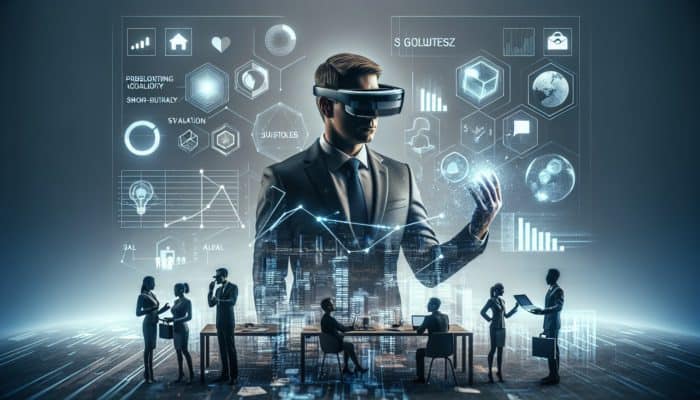Leveraging Augmented Reality to Drive Small Business Growth
Recently, augmented reality (AR) was predominantly seen as a cutting-edge technology reserved for tech giants based in Silicon Valley or confined to the realms of gaming. For a significant number of small business owners, AR seemed like a lavish luxury, financially unattainable. Yet, upon entering a café in Cape Town, a boutique in London, or a hair salon in Yeovil, one might witness AR experiences actively reshaping how customers explore, sample, and purchase items.
AR has evolved from a fanciful idea into an essential and accessible tool crucial for business expansion. Small enterprises that once relied solely on competitive pricing or outstanding customer service can now tap into the same interactive technologies that have elevated brands like IKEA, Sephora, and Warby Parker to new heights. The incredible reality today is that embracing AR no longer necessitates a multimillion-pound investment.
So, what are the key implications of AR for small business growth, and how can you harness it effectively for your advantage? Let’s delve deeper into this fascinating subject.
What Makes AR an Accessible Resource for Small Businesses?

AR has become increasingly accessible for small businesses because the significant barriers that once impeded its adoption — such as costs, required hardware, and consumer readiness — have dramatically diminished. The technology has turned more affordable, smartphones now come equipped with integrated AR capabilities, and customers are progressively demanding more immersive and engaging digital experiences, particularly in light of the rise in online shopping during the pandemic.
A decade ago, launching an AR initiative necessitated a dedicated development team and specialised equipment. In contrast, contemporary no-code platforms like ZapWorks and Spark AR empower café owners or local retailers to craft their own interactive filters and experiences without needing to write any code. Modern smartphones possess the processing power to render 3D previews in real time. Most importantly, consumers have grown increasingly adept at interacting with digital content due to the changes in shopping habits triggered by COVID-19.
This convergence of affordability, widespread hardware availability, and evolving customer expectations indicates that AR has finally transitioned from a far-off concept into a practical tool for everyday use.
How Can AR Provide a Competitive Edge for Small Businesses?
AR offers small businesses a distinctive competitive advantage by allowing them to present themselves as innovative and memorable, even without the substantial resources that larger corporations possess. When customers encounter something fresh and captivating, they are more likely to remember it, which increases the likelihood of selecting that brand over others.
For instance, in the eyewear sector, Warby Parker pioneered AR glasses try-ons, surpassing established high-street competitors like Specsavers. This strategic move solidified their reputation as retail trailblazers. Today, independent opticians can achieve a similar impact by employing Instagram filters at minimal costs.
The furniture retail market provides another compelling example. The IKEA Place app enables customers to visualise sofas in their living spaces before committing to a purchase. This innovation was groundbreaking at its inception, but now platforms like Shopify offer AR previews for any retailer. Even a single-store furniture seller can compete in the innovation landscape once dominated by multinational corporations.
This level playing field is significant. AR has the potential to transform a quaint boutique into a cutting-edge venue, a salon into a high-tech experience, and a local café into a futuristic establishment. For many small businesses, this enhanced perception fosters customer loyalty and encourages repeat visits.
What Influence Does AR Have on Customer Engagement?
AR is transforming customer engagement by turning passive browsing into active exploration. Rather than merely viewing static product images, customers can virtually try, position, or interact with products prior to making a purchase — and this heightened engagement directly boosts their confidence in their purchasing decisions.
Virtual try-ons exemplify this effect vividly. A boutique in London offered AR sunglasses previews via Instagram, enabling customers to swipe through various styles and observe how each one appeared on their faces. The outcome? An impressive 27% surge in sales within three months, alongside a reduction in return rates. Reports from Shopify indicate that merchants implementing AR or 3D previews in their offerings experienced nearly double the conversion rates compared to those using flat images.
In the food and hospitality sectors, AR has also been deployed with remarkable results. For example, pizzerias in New York now allow diners to scan QR codes to view animated 3D dishes. This simple addition led to over a 20% increase in orders for premium toppings. Similarly, a bakery in Manchester organised an AR scavenger hunt during Easter, prompting customers to scan hidden codes throughout the shop, which resulted in a nearly 20% increase in foot traffic and a spike in social media engagement.
The conclusion is clear: customers engage more deeply when given opportunities for interaction. And when customers engage, they are significantly more likely to complete their purchases.
Can AR Enhance Personalised Marketing Strategies for Small Businesses?

Absolutely. AR transforms marketing into an interactive and personalised experience, allowing customers to engage with offers and promotions in ways that traditional static advertisements cannot achieve. This level of interactivity enhances recall and converts campaigns from simple advertisements into enjoyable experiences.
For instance, a café in Cape Town executed a campaign where pedestrians scanning a poster outside the shop unlocked a virtual coffee voucher. The redemption rates soared to three times higher than traditional paper flyers. In Yeovil, a salon developed an AR hairstyle filter for Instagram, which quickly circulated through local networks and resulted in a 15% increase in bookings within just fourteen days.
Additionally, Starbucks has explored AR-powered loyalty programmes where customers can collect digital stamps. Independent cafés have since replicated this concept using free AR tools, providing customers with an added element of excitement alongside their daily coffee.
Unlike conventional advertising methods that can feel intrusive, AR campaigns actively invite users to engage. Customers are not just passive spectators; they become active participants in the experience. This active involvement significantly raises the likelihood that they will remember, share, and act upon the experience.
How Can AR Streamline Daily Business Operations?
AR not only enhances customer-facing elements of a business; it also significantly boosts internal efficiencies. For many small enterprises, staff training, inventory management, and maintenance tasks can be continuous drains on time and resources. AR introduces innovative solutions to streamline these processes.
Training: Onboarding can be both costly and inconsistent. With AR, staff can follow step-by-step visual overlays in real-world environments. For instance, a new barista can learn to operate the espresso machine by following visual instructions projected directly onto the machine itself. Research from Deloitte indicates that AR training can reduce onboarding time by up to 40% while improving knowledge retention compared to traditional training manuals.
Inventory: Retailers and small supermarkets are using AR to visualise stock levels and identify missing items. Employees can scan shelves and instantly see what needs restocking. Pilot programmes in Europe have shown time savings of 20–30% during stock checks, along with reduced waste.
Maintenance: Equipment failures can severely impact small businesses. With AR overlays, staff can quickly troubleshoot issues. A café can resolve problems with its coffee machine, a gym can maintain its treadmills, and an auto repair shop can diagnose faults more efficiently. This capability minimises downtime and saves costs associated with emergency repairs.
By incorporating AR behind the scenes, businesses can reduce inefficiencies and allocate more time to what truly matters: serving their customers.
What Affordable AR Solutions Are Available for Small Businesses?
Contrary to common misconceptions, AR does not require a custom app or a large budget. Numerous accessible tools are currently available:
| Tool | Best Use Case | Cost |
|---|---|---|
| Spark AR (Meta) | Create Instagram/Facebook filters | Free |
| Lens Studio (Snapchat) | Develop viral AR lenses | Free |
| Shopify AR | Incorporate 3D product previews into stores | Included with Shopify |
| ZapWorks | No-code AR campaign creation | Subscription-based |
| PlugXR | Rapid AR prototyping | Free & paid tiers |
| Canva Smartmockups | User-friendly AR visuals for marketing | Part of Canva Pro |
Furthermore, freelancers and agencies are offering affordable custom AR development services. On platforms like Upwork, small businesses can connect with specialists to create tailored AR campaigns for under £1,000. This pricing structure firmly positions innovation within reach for independent retailers and service providers.
What Steps Should Small Businesses Take to Launch Their AR Journey?

The most effective way to embark on your AR journey is to identify a specific challenge that AR can address, showcase tangible results, and then progressively expand upon those successes. Many businesses complicate their initial steps and hinder their progress. A more effective strategy is to adopt an incremental approach.
-
Identify a Pain Point. Are your customers hesitant to make purchases? Implement AR previews. Is training taking too long? Utilize AR for onboarding. Do you need to boost foot traffic? Launch an AR filter.
-
Select a Tool. If your target audience is on Instagram, start with Spark AR. If you manage an e-commerce store, consider Shopify AR.
-
Develop a Pilot. Keep the scope manageable. Focus on one product preview, one filter, or one AR loyalty reward.
-
Evaluate Results. Monitor engagement levels, sales growth, or training efficiency to enhance performance.
-
Scale Successful Initiatives. Expand your offerings to include more products, filters, or processes.
This “start small, scale big” strategy allows for low-risk AR adoption and ensures alignment with measurable business outcomes.
What Future Opportunities Does AR Present for Small Business Development?
AR is increasingly serving as a gateway to the metaverse and mixed-reality experiences. While the comprehensive vision of the metaverse is still in development, current AR adoption prepares businesses for a future where hybrid digital-physical shopping experiences are commonplace.
Technologies such as Apple’s Vision Pro, Meta’s Horizon, and Microsoft’s HoloLens are driving the pursuit of more immersive experiences. Early adopters will be strategically positioned to seize opportunities when AR storefronts, virtual events, and mixed-reality trade shows become mainstream.
Small businesses should not hastily enter the metaverse without careful consideration. However, by experimenting with AR today, they can future-proof themselves. When immersive shopping and digital environments become the norm, they will already possess the skills, mindset, and customer trust necessary to thrive.
Is AR a True Growth Catalyst for Small Enterprises?
Indeed — and the evidence supporting this assertion is continually growing. AR enhances conversions by alleviating customer uncertainty. It fosters customer loyalty by creating memorable, shareable experiences. Additionally, it streamlines operations by saving valuable time and reducing costs. Furthermore, it positions small businesses as local innovators.
For many business owners, the initial step can be the most daunting. Yet, those who take this leap quickly discover that AR is less about flashy technology and more about resolving real challenges in smarter, more effective ways.
How Can You Commence Your AR Journey Today?
For small businesses, AR has shifted from a luxury item to a practical, affordable engine for growth. There is no necessity to develop a complex app or to invest considerable sums. All that is required is to begin by identifying one specific problem that AR can solve — whether that involves allowing customers to visualise how a sofa would appear in their home, enabling diners to preview a dish before ordering, or accelerating the training of a new employee.
From this initial step, the possibilities for expansion are vast. Businesses that engage in experimentation today will secure a competitive advantage for the future. Moreover, since AR levels the playing field, this advantage is not solely reserved for multinationals. It is accessible for the café, the salon, the bookstore, and the local service provider willing to take the initiative.
Consequently, the crucial question is not “should small businesses adopt AR?” but rather “which AR experience will you implement this month?”
Frequently Asked Questions About AR in Business
What Role Does Augmented Reality Play in Business?
Augmented reality (AR) overlays digital information onto the physical world using smartphones or AR glasses. For businesses, this enables customers to preview products, interact with engaging advertisements, or enjoy enriched in-store experiences.
How Can AR Foster Small Business Growth?
AR aids small businesses in boosting sales by minimising purchase uncertainty, attracting more customers through interactive campaigns, and streamlining operations like training and inventory management. It effectively levels the competitive landscape against larger rivals.
Is Implementing AR Expensive for Small Businesses?
Not anymore. Free and reasonably priced AR tools such as Spark AR, Shopify AR, and ZapWorks enable small businesses to create engaging experiences without incurring significant financial investment. Moreover, freelancers offer custom AR projects for under £1,000.
Can AR Improve Sales Conversions?
Absolutely. Research suggests that AR previews can potentially double conversion rates compared to conventional static images. By allowing customers to virtually try or position products, AR reduces hesitation and encourages confident purchasing decisions.
Does AR Help Reduce Product Returns?
Indeed. Virtual try-ons and previews ensure customers are well-informed about their purchases before checkout. Retailers utilising AR have reported return rates plummeting by as much as 40%, resulting in both time and cost savings.
How Does AR Improve Customer Engagement?
AR transforms browsing into an interactive experience. From AR scavenger hunts to 3D menu previews, customers are more likely to engage with your brand, share their experiences, and promote word-of-mouth referrals, all of which contribute to heightened brand loyalty and advocacy.
Is AR Useful for Local Marketing Campaigns?
Absolutely. AR posters, QR codes, and location-based filters empower small businesses to effectively target local customers. These interactive campaigns often outperform traditional print or static digital advertisements.
Which Industries Benefit Most from AR?
Sectors such as retail, beauty, food service, hospitality, healthcare, and fitness are at the forefront of AR adoption. Any business where customers wish to try, see, or learn prior to committing to a purchase can benefit from implementing AR.
How Do AR Filters Work on Instagram and Snapchat?
Filters created using Spark AR or Lens Studio overlay effects or branded content can be applied in real-time. Customers can interact, share selfies or stories, and virally boost brand awareness across social media platforms.
Can AR Enhance Employee Training?
Yes. AR overlays provide step-by-step guidance for various tasks, ranging from brewing coffee to repairing machinery. Businesses utilising AR for training can minimise errors and accelerate onboarding by as much as 40%.
Does AR Aid in Inventory Management?
AR-enabled applications assist in visualising stock levels, identifying missing items, and optimising shelf arrangements. This capability saves staff time and reduces errors compared to traditional manual stock-checking methods.
Is AR Exclusively Beneficial for Online Retailers?
No. Physical retail locations also reap benefits. AR can create gamified in-store experiences, engaging loyalty programmes, and AR menus that enhance the overall customer experience during visits.
What Distinguishes AR from VR in Business?
AR augments the real world with digital elements, while VR immerses users in a fully virtual environment. AR is typically more practical for small businesses since it requires only a smartphone for implementation.
Do Customers Actively Use AR When Shopping?
Yes. Surveys indicate that over 70% of consumers are more inclined to purchase from retailers providing AR experiences. Younger demographics, particularly Gen Z and Millennials, actively seek out AR opportunities.
Can AR Promote Customer Loyalty?
Certainly, interactive loyalty programmes, gamified rewards, and personalised AR experiences make customers feel engaged and valued, encouraging them to return for repeat visits.
What Is the Simplest Way to Start Using AR?
Begin with a straightforward use case: a product preview for a single item, an individual AR Instagram filter, or a simple loyalty campaign. Evaluate the results, then scale up what proves effective.
Is a Dedicated App Required to Use AR?
Not necessarily. WebAR tools and social media filters allow customers to access AR experiences directly through their existing browsers or apps, eliminating the necessity to download any additional software.
Is AR Relevant for Service-Oriented Businesses?
Absolutely. Salons can provide hairstyle previews, gyms can guide workout sessions, and repair services can display troubleshooting overlays. AR enhances experiences beyond just products.
How Does AR Connect to the Metaverse?
AR acts as a bridge to the metaverse. Businesses adopting AR today will be prepared for immersive digital storefronts, hybrid events, and mixed-reality shopping as these innovations gain traction.
What Does the Future Hold for AR in Small Businesses?
The future promises broader AR implementation in retail, hospitality, and local marketing, driven by technologies like Apple Vision Pro. Small businesses experimenting with AR today will enjoy a competitive edge moving forward.
Connect With Us on LinkedIn
Presented By: Digital Marketing in Yeovil
The post Augmented Reality’s Impact on Small Business Growth appeared first on Ezi Gold.
The Article Augmented Reality Boosts Growth for Small Businesses Was Found On https://limitsofstrategy.com


